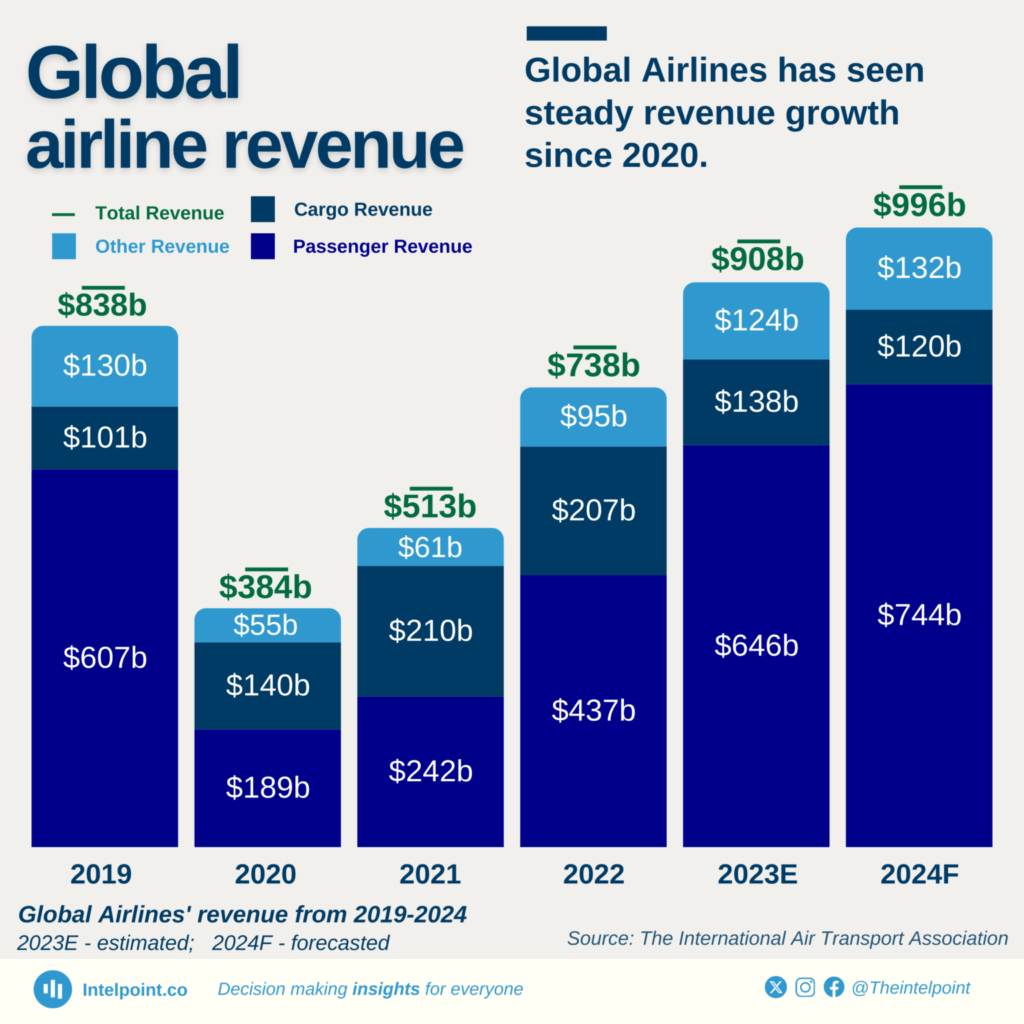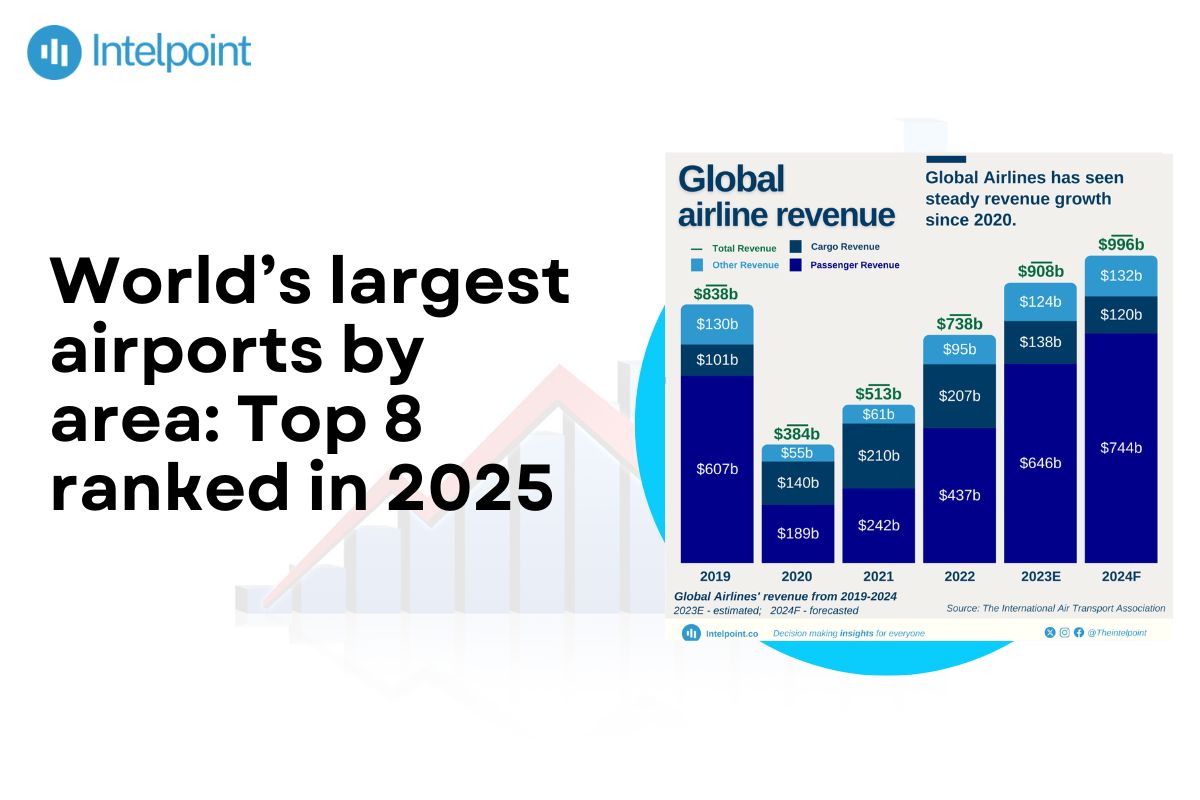Airports generally generate significant economic activity, creating jobs in various sectors, including construction, logistics, and aviation services.
Their size and capacity demonstrate a country's commitment to aviation and its role in international commerce. When an airport expands to a “mega” scale, it is regarded as a strategic infrastructure that shapes regional development and influences global trade routes.
In this report, we focus on the top 8 largest airports by land area.
Key takeaways
- The airport area is designed for future growth, not just in terms of passenger numbers. King Fahd International covers 776 square kilometres and focuses on its capacity, rather than the 12 million travellers it currently serves each year.
- A big airport doesn't equal people traffic. For example, Denver International is 135.7 square kilometres and recorded 80 million passengers in 2024.
- Large airports also manage cargo, military, or commercial areas, such as Dallas-Fort Worth, which spans 69.6 square kilometres.
- Deserts in Saudi Arabia allow for the construction of large airports, while cities limit the sizes of others.
Meanwhile, globally, airlines experienced over 100% revenue growth from 2020 to 2023, with passenger revenue being the primary driver of this growth.

Global airline revenue 2019-2024
Cargo revenue also contributed significantly to the overall increase.
Criteria for ranking airports by area
To determine the largest airports in the world by area, we examined the total land area measured in square kilometres, which includes essential infrastructure and operational areas.
- Area Definition: This includes runways, taxiways, terminals, parking lots, cargo areas, hangars, and the roads on the airport grounds. We also considered designated buffer zones for airport operations, but we did not include nearby private properties.
- Data Sources: We gathered information from official reports by airport authorities, the International Civil Aviation Organization (ICAO), and Airports Council International (ACI).
Top 8 largest airports by area
Below are our top picks of the largest airports, including airport name, location, area in square kilometres, and annual flights. But before that, here's a quick highlight of what you'll learn in this post.
| Airport Name | Location | Area (km²) |
| King Fahd International Airport | Dammam, Saudi Arabia | 776 km² |
| King Khalid International Airport | Riyadh, Saudi Arabia | 375 km² |
| Denver International Airport | Denver, Colorado, U.S.A. | 137.8 km² |
| Kuala Lumpur International Airport | Kuala Lumpur, Malaysia | 100 km² |
| Dallas Fort Worth International Airport | Dallas, Fort Worth, Texas, U.S.A. | 69.6 km² |
| Orlando International Airport | Orlando, Florida, U.S.A. | 69.6 km² |
| Washington Dulles International Airport | Washington, D.C., U.S.A | 52.6 km² |
| Beijing Daxing International Airport | Beijing, China | 47 km² |
1. King Fahd International Airport (DMM), Dammam, Saudi Arabia
- Area: 776 km² (191,754 acres)
- Annual Flights: 99,000 operations in 2024
Roughly equivalent to the combined area of all five boroughs of New York City, King Fahd International Airport in Dammam holds the Guinness World Record for being the largest airport globally by land area. Despite accommodating only 12 million passengers in 2024, which is significantly fewer than many other major airports, its large area reflects Saudi Arabia's vision of leading the aviation sector.
The airport features extensive runways, cargo facilities, and a dedicated terminal for royalty. The facility has ample space for future expansion. Its desert location contributes to this enormous size, making it far larger than urban airports.
Note:
- While the airport property spans 776 km², the official website reports a utilised area of only 36.75 km² (9,080 acres), which would make it the sixth-largest in the world in this context.
2. King Khalid International Airport (RUH), Riyadh, Saudi Arabia
- Area: 375 km² (92,664.52 acres)
- Annual Flights: 217,000 operations in 2024
King Khalid International Airport (RUH), located 35 km north of Riyadh, covers an area of 375 square kilometres, making it the second-largest airport in the world by size. In 2024, it accommodated 37.2 million passengers and managed 269,000 flights, acting as a key hub for Saudia and Flynas.
The airport features five terminals, including Terminal 5, which opened in 2016, and has two runways, each measuring 4,205 metres in length. These accommodate both cargo and VIP services.
An expansion planned for 2025 aims to increase capacity to 120 million passengers by 2030, in line with Vision 2030. A central mosque and an 81-metre control tower highlight its cultural importance.
3. Denver International Airport (DEN), Denver, U.S.A
- Area: 137.8 km² (33,531 acres)
- Annual Flights: 694,900 operations in 2024
Denver International Airport, the largest airport in North America by land area, spans 53.2 square miles (135.7 square kilometres) and reportedly served 82,358,744 passengers in 2024, a 5.8% increase over 2023.
The year 2024 was the first year in history that Denver International Airport served more than 80 million passengers. Its iconic peaked-roof terminal resembles the Rocky Mountains of Colorado and stands as a remarkable feat of design.
The airport's large area accommodates numerous runways, cargo operations, and even some interesting conspiracy theories regarding underground facilities.
4. Kuala Lumpur International Airport (KUL), Kuala Lumpur, Malaysia
- Area: 100 km² (24,710.54 acres)
- Annual Flights: 403,392 operations in 2024
Kuala Lumpur International Airport (KUL) is located in Sepang, Selangor, 45 km away from Malaysia’s capital. In 2024, KUL served 57.1 million passengers and processed 794,943 tonnes of cargo, reinforcing its status as the busiest hub in Malaysia for Malaysia Airlines and AirAsia.
The airport's master plan, which is being executed in three phases, is scheduled to reach completion of Phase Two by 2025, aiming to accommodate 100 million passengers annually. This expansive airport features three runways, two terminals, and a satellite building that includes a rainforest, earning it the UN Green Globe 21 certification.
5. Dallas Fort Worth International Airport (DFW), Dallas Fort Worth, U.S.A.
- Area: 69.6 km² (17,193.57 acres)
- Annual Flights: 743,203 operations in 2024
The Dallas Fort Worth International Airport stands as a significant hub for the cities of Dallas and Fort Worth. Serving about 73 million passengers in 2024, DFW’s large area accommodates five terminals and extensive cargo operations, and plays a vital role in the U.S.’s domestic and international logistics.
Its large size allows for different functions, including maintenance facilities and commercial spots. As confirmed by airport authority reports from 2025 and ICAO, DFW’s strategic positioning enhances connectivity throughout the Americas.
6. Orlando International Airport (MCO), Orlando, U.S.A.
- Area: 69.6 km² (17,193.57 acres)
- Annual Flights: 400,090 operations in 2024
With the same area as DFW, Orlando International Airport serves as a major U.S. gateway, accommodating 50 million travellers in 2024. Initially established as a military base, MCO evolved into a popular tourist destination, thanks to its proximity to Disney World and Universal Studios.
The airport features four runways, ample parking, and cargo facilities. These all help bolster Florida's tourism-centric economy. MCO's expansive size and adaptability position it as an essential hub for both leisure and international travel.
7. Washington Dulles International Airport (IAD), Washington D.C., U.S.A.
- Area: 52.6 km² (12,997.28 acres)
- Annual Flights: 250,000 operations in 2024
Washington Dulles International Airport serves the U.S.A.’s capital region, with a record of approximately 24 million passengers in 2024. This extensive space is ideal for long-haul international flights, diplomatic travel, and cargo operations, highlighted by its famous terminal designed by Eero Saarinen.
The airport's size, confirmed by ICAO and airport reports from 2025, enhances its status as a global gateway, providing room for future growth. Its prime location close to Washington, D.C., further elevates its significance in both political and economic connections.
8. Beijing Daxing International Airport (PKX), Beijing, China
- Area: 47 km² (11,614 acres)
- Annual Flights & Passengers: 262,100 operations in 2024
Known as the "Starfish" due to its stunning design, Beijing Daxing International Airport spans 47 square kilometres and features the world's largest single-terminal building, covering 700,000 square metres. Recording 45 million passengers in 2024, it is emerging as a key Asian hub, with projections for 2025 approaching 70 million.
With an extensive layout, confirmed by ICAO and airport statistics, the facility accommodates large runways and cargo areas, with additional expansion plans in the works. Daxing’s innovative design and size are a testament to China’s aspirations in aviation.
Final note
Top players, such as King Fahd (776 km²) and King Khalid (375 km²), embody strategic foresight, with cargo centres and plans for future growth, thereby enhancing worldwide connectivity.
In 2025, as air traffic is expected to reach 9.9 billion passengers, according to Airports Council International (ACI) World, these major airports will be at the forefront of innovation and economic power.




